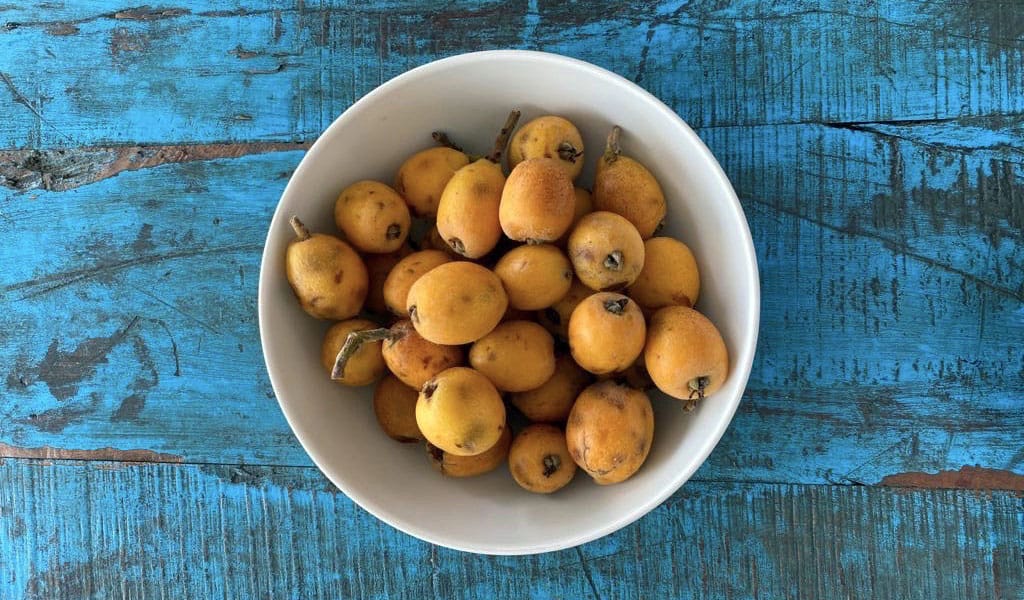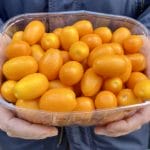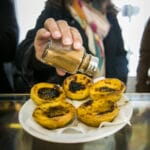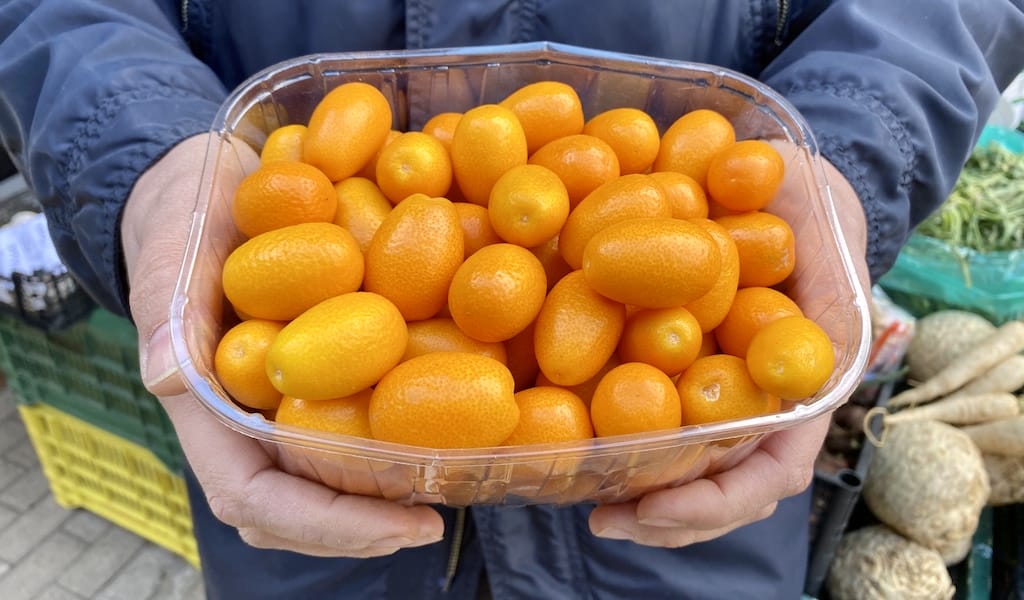A ripe loquat is a thing of beauty. For a short window of time, usually in April and May, trees heavy with the fruit can be spotted across Lisbon, in both public parks, private gardens and tiny backyards. We have a few favorite ones that we frequent, sometimes surreptitiously, during loquat season to pluck the small, butterscotch-colored fruit and fulfill our craving. But we have to be quick – loquats are as short-lived as they are delicious.
Adriana Freire, the founder of Cozinha Popular da Mouraria, a community kitchen, knows the city’s loquat trees even better than we do. Although a popular spring fruit in Portugal, many of Lisbon’s loquat trees are ornamental in nature and often left unpicked. Freire, in an attempt to prevent waste, started the project Muita Fruta, a neighborhood association that maps the city’s loquat trees and gathers fruit from them to be transformed into jelly, jam or chutney.

Good loquats can be found all over the country – easy to grow, the tree, an import from Asia, has adapted very well to Portugal’s climate. In the Azores and Madeira, where it’s warmer and rainier, they show up a bit earlier and are often sweeter. The former is known for its loquat jam, perfect for São Jorge cheese (named after the Azorean island where it’s made), jelly and loquat liqueur, while in Madeira they make a liqueur from the seeds. In mainland Portugal, the best and most productive loquat trees are in the Algarve, a southern region known for its sunny weather.
While its botanical name – Eriobotrya japonica – would suggest otherwise, loquats are native to China, although they have been cultivated in Japan for centuries and are still highly valued in the country. The fruit was likely introduced to Portugal around the 16th century, when Portuguese traders and missionaries returned from China and Japan bearing a number of new fruits and plants. But they only began to be cultivated, mainly for ornamental purposes, in the 18th century. Later, in the 19th century, they were introduced to the Azores, where they flourished in the gardens of São Miguel and fascinated islanders with their exquisite flavor.
 In Portugal, the most common variety of loquat – called nêspera in Portuguese, from the Greek méspilos, although in northern Portugal it’s called magnório or magnólios, thought to be after the French botanist Pierre Magno – is Tanaka. These are the small ones you’ll see in many gardens and backyards. Even though they’re often the sweetest and juiciest, these loquats are not popular with commercial growers, perhaps because of their small flesh to seed ratio. Sadly, supermarket chains tend to carry other imported varieties, mainly from Spain, which lack flavor since they were picked before they were ripe.
In Portugal, the most common variety of loquat – called nêspera in Portuguese, from the Greek méspilos, although in northern Portugal it’s called magnório or magnólios, thought to be after the French botanist Pierre Magno – is Tanaka. These are the small ones you’ll see in many gardens and backyards. Even though they’re often the sweetest and juiciest, these loquats are not popular with commercial growers, perhaps because of their small flesh to seed ratio. Sadly, supermarket chains tend to carry other imported varieties, mainly from Spain, which lack flavor since they were picked before they were ripe.
Since this spring favorite requires a lot of time and labor – to peel the skin, remove the big seeds and the inner skin – it’s not often that we find loquats on the menus of restaurants and cafés in Portugal’s big cities. They are an excellent fruit for cooking or baking, with a nice acidity and delicious taste, sometimes a bit tart when not totally ripe. The flavor is quite unique, as if an apple procreated with an apricot and a plum.
Chef António Galapito, from Prado, loves nêsperas both in desserts and in savory dishes. “We used to do a dessert in Taberna do Mercado [Nuno Mendes’ London restaurant] with loquats and almonds, and here in Prado I have used it in a meat dish. When they are sweet and ripe they really pair well with porco alentejano [black pig from Alentejo],” he tells us.
Although a popular spring fruit in Portugal, many of Lisbon’s loquat trees are ornamental in nature and often left unpicked.
Galapito, who is currently working on a new menu for Prado that will debut on April 19, when restaurants are allowed to reopen for indoor dining, also imagines that a loquat sorbet would go down well. Unfortunately, working with loquats is too difficult in his current set-up. “They are so small, and it takes so much work to peel them and get rid of the seeds. Plus, the season is so short,” he explains.
Filipe Rodrigues from Taberna do Mar, which is set to reopen their terrace on April 7, shares the same love for loquats but sees the same obstacles: “For a small kitchen team, it’s difficult to work with a fruit like the loquat – you need to peel the skin and remove the seeds,” he says. “In fine-dining restaurants perhaps it’s easier but for us it doesn’t work.”
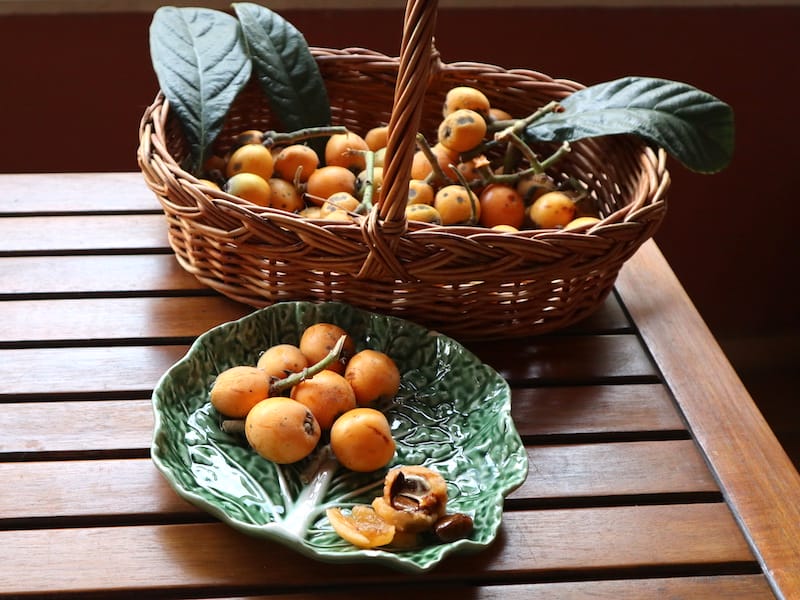
The chef is also quick to suggest a loquat ice cream, when we ask how he would use the fruit. Or a tart topped with caramelized loquats. On the savory side, he is fond of a salad made of arugula, cottage cheese (or ricotta), walnuts and loquats, which sounds ideal for spring.
While both Galapito and Rodrigues would like to give more attention to loquats, for now we will have to go it alone and use their suggestions for the pile of fruit that we have already amassed. After all, loquats are full of good nutrients – Vitamin A, potassium, antioxidants and pectin – and the Direcção-Geral de Saúde (the Portuguese Department of Health) recommends the fruit on its website, stating that, among other virtues, loquats contain natural cell protectors that help guard your skin against the summer sun. We knew there was more than one reason for loving this small fruit so much.
Editor’s note: Here at Culinary Backstreets, we eagerly await the coming of spring each year, not just for the nicer weather but also because some of our favorite foods and dishes are at their best – or indeed, are only available – for a short period during this season. So we are running a weeklong celebration – “Spring (Food) Break 2021” – of our favorite springtime eats.
Published on April 08, 2021
Related stories
April 6, 2021
AthensAs winter winds down and spring begins to bloom, Stelios Charkiolakis makes space on the overflowing shelves of his produce shop in downtown Athens for crates of tiny, jewel-like kumquats. Prized by local chefs, these little treasures have come all the way from Corfu. Depending on the weather, the kumquat harvest can begin in late…
August 14, 2017
Mexico CityIn Mexican cuisine, sweets are for the most part simple treats that are enjoyed at the park, market or beach, such as caramelized fruits and vegetables, blocks of nuts or amaranth seeds held together with honey, or small rice paper cakes filled with honey. The common denominator of most of these sweets is their simplicity.…
April 4, 2024
LisbonQuick Bite: On this food tour in Lisbon, we’ll experience a cultural feast, tasting some of the most diverse bites of the city’s gastronomy and meeting the people behind them. The oldest city in Western Europe, once the hub of a trading empire that connected Macau in the east to Rio de Janeiro in the…







































